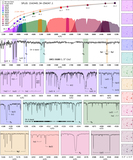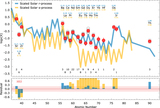Image Details

Caption: Figure 8.
﹩\mathrm{log}\epsilon (\mathrm{Th}/\mathrm{Eu})﹩ (left panel) and ﹩\mathrm{log}\epsilon (\mathrm{Eu})﹩ (right panel) as a function of [Fe/H] for metal-poor stars in the literature with both Th and Eu measured ([Fe/H] ≤ −1.0 and [Eu/Fe] ≥ +0.60), compared to SPLUS J1424−2542. The point sizes are proportional to [Eu/Fe] (left) and [Th/Fe] (right), according to the labels between the panels. The horizontal solid gray line marks the solar ﹩\mathrm{log}\epsilon (\mathrm{Th}/\mathrm{Eu})﹩ value and on the right panel, the limits for the r-II and r-III stars are shown. Individual references are given in Table 6.
Copyright and Terms & Conditions
© 2023. The Author(s). Published by the American Astronomical Society.













